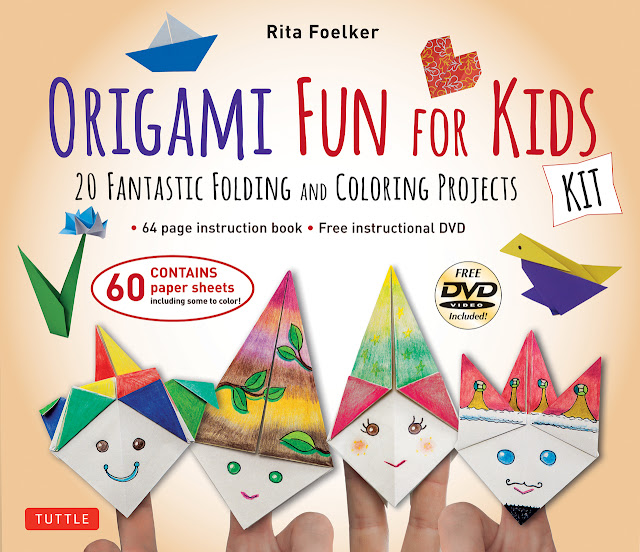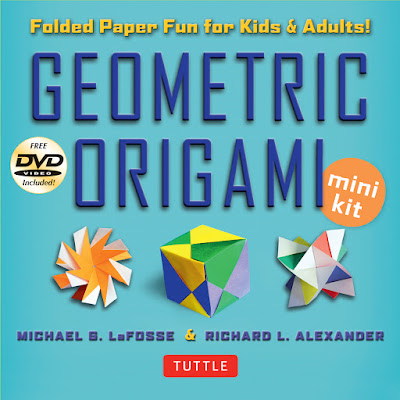Sharing Saturday is still open!! Please stop by to share your child-oriented crafts and activities or to be inspired by the amazing ideas already shared!
Since
my post for Friday was on butterflies I thought I would show you some more butterflies I have made (and have given to Hazel to decorate though she seems to just like to play with them). (The post on Friday included some children's books about butterflies.)
These are all made with a technique called origami. I love origami. I used it as a math teacher to teach different skills and have just always thought the Japanese art of paper folding was really neat. Some is easier than others and I will get into this more later. I am going to start by giving you a bit of the history of paper and origami. My sources for this history will be two books: The Simple Art of Japanese Papercrafts by Mari Ono and Origami Flowers by Soonboke Smith.
Asian and Polynesian peoples are known to have created ceremonial and utilitarian handicrafts by folding and wearing ti leaves, palm fronds, and pounded mulberry bark long before paper was ever invented. This was the origins of origami. The word origami is the Japanese word for paper folding. (Source: Origami Flowers)
Papermaking was invented in China at the beginning of the second century and was brought to Japan in the sixth century CE. The original paper brought to Japan was weak and the people demanded better paper. The Japanese discovered that a plant indigenous to Japan, gampi, was an ideal raw material for paper and they used a new method to produce it. This created washi paper. In the eighth century a new method was developed using hemp and kozo. This method is called the nagashizuki method. It allowed for unusally thin, strong, resistant paper to be made. With these developments the use of paper became more than just for official documents and transcription of religious texts because paper was more available.
The origin of origami is not completely known. Parts of it began to appear in different areas of Japan. When paper became more available, it became common for people to make cranes and boats and use them as decorations. The first origami book, The Secret of One Thousand Origami Cranes by Hiden Senbazuru Orikata was published in 1797.
In 1873 at the Vienna World Exposition the world was amazed to see all the things made out of paper by the Japanese. Until 1853 Japan was very isolated from the world. (Source: The Simple Art of Japanese Crafts)
I have to admit my nephew loves origami. While I was at the Cape last time he was visiting and we did quite a bit of origami together. I left my book there so he and my mother could continue to make some. I meant to take some pictures of the things we made, but alas I did not and left them there.
 |
| Some of my sources for my butterflies! |
Now onto our butterflies. While at the Mass Audubon Ipswich River Wildlife Sanctuary Gift Shop, I found an origami butterfly kit (see picture on top of collage above). This was the start of my idea. I had several butterfly crafts to try and thought it would be neat to do some out of origami as well. Unfortunately I had some difficulties with the instructions. After several tries, I decided to practice with printer paper so I would not keep wasting my good origami paper (and the paper in the kit was double-sided to make more colorful butterflies).
After figuring this one out with the printer paper, I have not gone back and tried it with the origami paper. However, I loved the idea of being able to do make some with Hazel's drawings and paintings. This has not happened yet, but it will.
This purple butterfly was made from the instructions in the book, Making Origami Animals by Michael G. LaFosse (bottom left in collage above).
This pink butterfly includes a pipecleaner body and antennae. It was made using the instructions in the Holiday Origami book by Jill Smolinski (bottom right in collage above). It had the butterflies as an introduction to spring.
This dual color butterfly was among the easiest I made. The instructions came from
Hansbirkeland.
The cabbage butterfly was among the next easiest for instructions found on line. These instructions came from the
Origami Club.
The instructions for this beautiful butterfly are also on-line at
Fabric Origami.
Although this one looks simple, it has more steps than most of the ones I made. With fifteen steps, it is definitely not simple. I found this one at
Origami-fun.
My final butterfly had twenty-one steps! It is a butterfly by Akira Yoshizawa. There are several videos on-line for the Yoshizawa butterfly. I found the instructions at this
blog.
If you would like even more of a challenge than twenty-one steps, you can check out these books. They had 50-100 steps for the butterflies, but they were complete with their six legs and all. I did not adventure that much to try them. Sorry!
I would also like to share with you this wonderful book, Butterflies for Kiri by Cathryn Falwell. It is a wonderful story of how a girl who loves to draw and paint receives a gift of an origami kit on which her aunt had made an origami butterfly in the wrapping. Kiri tries to make the butterfly and has difficulty, but with practice eventually is able to make it. It has instructions to make an origami butterfly in it. I know I followed them, but am not sure which one it is anymore. I may have misrepresented one of the ones above (if I did I'm guessing the purple one) and its instructions came from here.



























